#goby
Text
Wet Beast Wednesday: pistol shrimp
Oh snap, it's the snapping shrimp post for Wet Beast Wednesday! Snapping shrimp or pistol shrimp are loud little critters that have evolves a very useful and fascinating tool in their pincers. Let's not waste time and shoot off to learn about these little gunslingers.
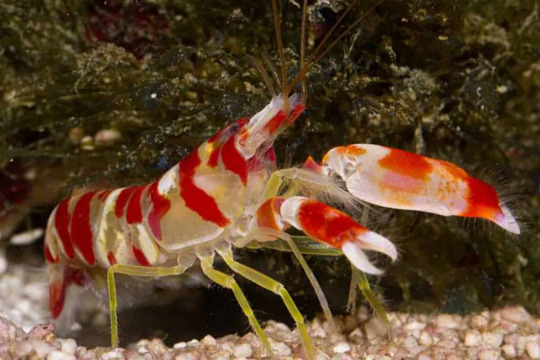
(Image: a pistol shrimp. It is a mostly white shrimp with red stripes. One of its claws is considerably larger than the other. It is standing on gravel and next to some seaweed. End ID)
Pistol shrimp are over 1,000 members of the family Alpheidae, which is part of the infraorder Caridea. This means they are true shrimp, not to be confused with superficially similar animals like brine shrimp, mantis shrimp, tadpole shrimp, and prawns. Yeah, I only recently learned that prawns and shrimp aren't a language difference between British English and American English like chips vs fries. They're not even that closely related. As true shrimp, pistol shrimp have two main body parts: the cephalothorax and abdomen, which are composed of 19 body segments. The abdomen forms a flexible tail with a fin on the end. When startled, the fin can rapidly curl under the body, propelling the shrimp backwards. Like other decapods, there are 10 limbs. The front pair of limbs have evolved into claws used to manipulate objects. The claws are the most distinguishing feature of pistol shrimp. They are asymmetrical, with one growing extremely large, over half the size of the body. The big claw has a modified version of the typical pincer. This pincer has an upper claw that can open up at a right angle. Under the claw is a pocket in the lower pincer, into which water flows. The upper pincer then slams down into this pocket, forcing the water out. The pressure of the pincer closing water in the pocket creates a cavitation bubble that is forced away from the claw at up to 26.8 meters per second. This is enough force to seriously wound small animals and hurt larger ones into leaving the shrimp alone. The cavitation bubbles can reach up to 4,427 degrees C (8,000 F) . For comparison, the surface of the sun is about 1,000 decrees (C) hotter. When the bubble pops, it creates a snapping sound that can reach 218 decibels. For comparison, most gunshots max out at around 170 db. This puts pistol shrimp is the running for the loudest ocean animals, with whales being the other main competitors. If that all sounds like a lot, the whole event happens so fast that the heat doesn't have time to affect much and the noise sounds like a moderately loud snap to us. Adults can snap their claws shut with an acceleration of up to 30 meters per second squared and juveniles can do it up to 20 times faster. The whole process takes less than a millisecond. When the cavitation bubble collapses, it can produce light. This is called sonoluminescence and nobody knows how it happens. If a pistol shrimp loses its large claw, the small claw will grow into a new large one while the missing limb will regenerate into a small claw. Adult pistol shrimp average between 3 and 5 cm long.
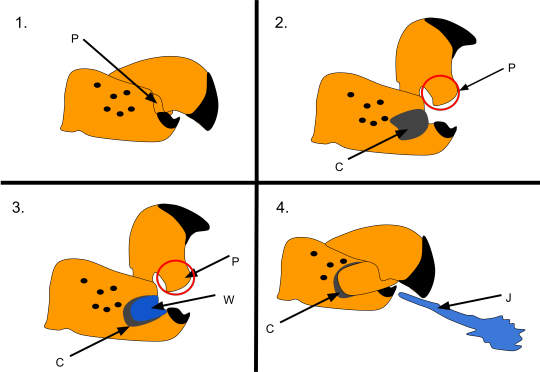
(Image: a drawing showing the process of a pistol shrimp snapping its claw. In the first panel, the claw is closed. In the second, the upper claw opens at a 90 degree angle, revealing a cavity. In the third panel, the cavity fills with water. In the final panel, the claw is closed again and a jet of water is ejected from the claw. End ID. Source: Wikipedia user Carermyers)
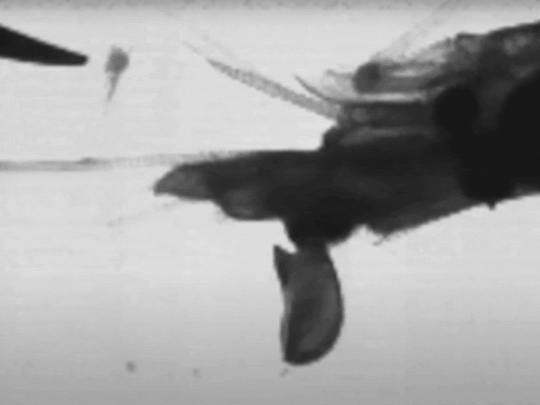
(Gif: black and white, slow-motion video of a pistol shrimp's claw snapping shut and creating a cavitation bubble. End ID. Source)
Pistol shrimp live worldwide, though most species live in tropical or temperate water. There are some cold water species and even freshwater species. Most prefer habitats where they can make burrows and where there are plenty of other animals. Coral reefs, oyster reefs, seagrass beds, mangrove groves are common habitats. Snapping is used for hunting and communication. They typically hide in burrows, waiting for fish or other small animals to pass by. When prey passes, the shrimp will snap to stun or seriously wound the prey, then drag it into the burrow. Some social species actually form eusocial hives with a single queen who produces all offspring. These shrimp are the only known marine eusocial species and all occur within the same genus (Synalpheus), though not every member of that genus is eusocial and eusociality appears to have evolved at least 3 times within that genus. It appears that a reason why only this genus developed eusociality is their larvae do not disperse, instead staying in the same area as the parents. The hives are usually located within sponges. Other social species are not eusocial, but still live together in colonies. Many less social species have formed a symbiotic relationship with gobies. Both species live in burrows, but gobies are bad at digging while the shrimp have poor eyesight. The goby will protect the shrimp while it digs a burrow, then the two live together. They will forage together, with the goby using its superior eyesight to watch for predators and warn the shrimp to get back to the burrow. Pistol shrimp are monogamous, the same pair coming back to mate over and over again (this does not apply to the eusocial species in which only the colony's queen is permitted to mate). The female is only fertile during a short period after molting. The male will stay with the female and protect her during the vulnerable period after mating and some species will remain with each other until the eggs hatch or permanently.
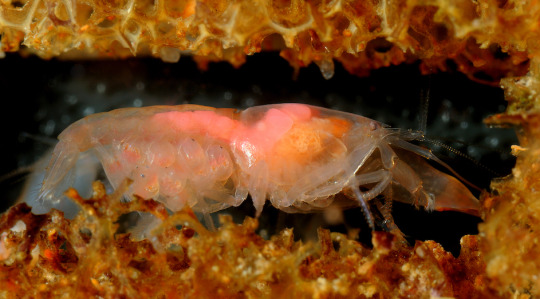
(Image: a eusocial pistol shrimp queen with eggs. Her body is translucent and multiple eggs are attached to her abdomen. The eggs look like translucent balls. The is inside of an orange sponge. End ID)
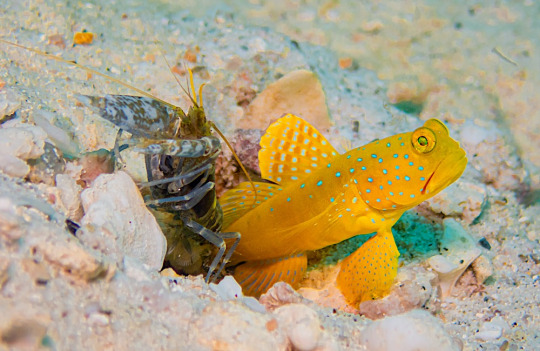
(Image: a pistol shrimp and goby emerging from a burrow in the sand. The shrimp is a mottled green and white. The body is a bright yellow fish covered with blue spots. End ID)
Pistol shrimp are a major source of noise in the places where they live. If you've ever been swimming and can hear repeated cracking noises, that may have been a bunch of pistol shrimp. Some scientists monitor the level of pistol shrimp noises as a method of monitoring the ecosystem. If the noise level drops, that is an indicator that the local ecosystem is suffering. The noise of the shrimps can get so loud that it actually interferes with sonar and forms of underwater communication. During World War II, members of the navy realized that the shrimp disrupted sonar enough to hide submarines, so they started hiding submarines near reefs with lots of the shrimp to keep them from being found by enemy subs. Weirdly not the only small marine animals to mess with submarines. I'll get the the other major one soon. The largest threats to pistol shrimp come from habitat destruction. Some species of pistol shrimp have entered the pet trade. As coral reefs, seagrass beds, and other habitats are destroyed, the shrimp that rely on them will suffer as well.

Yet another time I get to use one of these cards in a post
(Image: the Weird n' Wild Creatures card featuring pistol shrimp. End ID)
#wet beast wednesday#pistol shrimp#snapping shrimp#shrimp#decapod#crustaceans#marine biology#biology#zoology#ecology#animal facts#eusocial#symbiosis#goby#informative#image described
233 notes
·
View notes
Text
Daily fish fact #742
Adorned dwarfgoby!

Also known as seven-figure pygmy goby. With a maximum lifespan of only 59 days, it is the shortest-living vertebrate, and by extension, shortest-living fish. Larvae spend three weeks of their life floating in the open ocean, and two weeks of their life growing into mature adults, which leaves mature adults a whopping three weeks of time to find a mate and reproduce.
#rest assured this information is factual! i would never lie in fish facts#fish#fishfact#fish facts#fishblr#marine life#marine biology#marine animals#sea creatures#sea life#sea animals#biology#zoology#goby#adorned dwarfgoby#adorned dwarf goby#seven figure pygmy goby#seven-figure pygmy goby
283 notes
·
View notes
Text
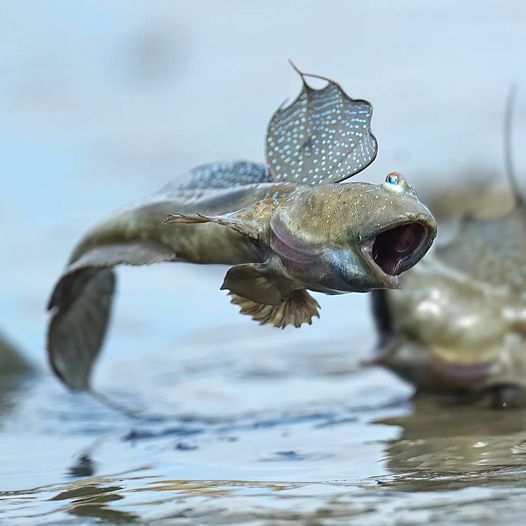
Great Blue-spotted Mudskipper (Boleophthalmus pectinirostris), family Oxudercidae, found on coastal mudflats in SE and East Asia
photograph by @joinus12345
407 notes
·
View notes
Text
btw i love any and all kinds of gobies. theyre all so silly and goofy
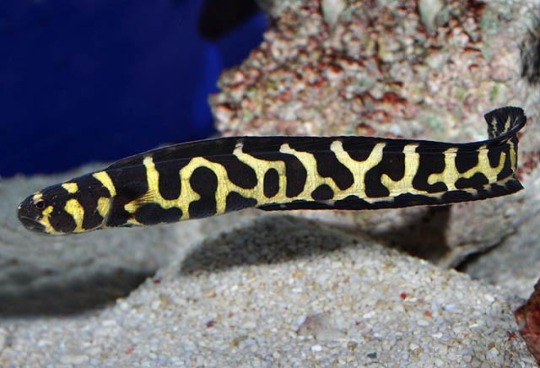


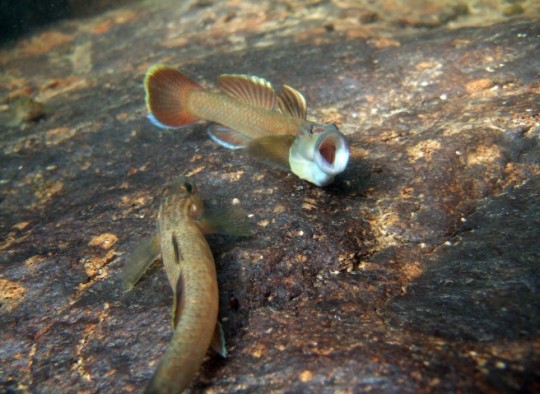
336 notes
·
View notes
Text

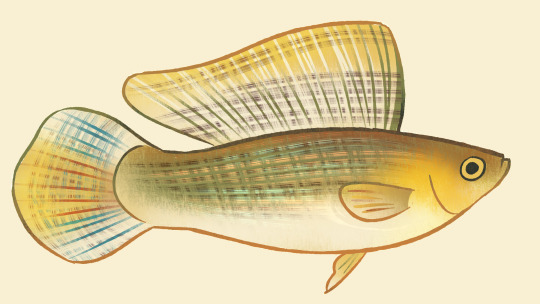
54 common fish of texas, part 16: naked goby (Gobiosoma bosc), sailfin molly (Poecilia latipinna)
91 notes
·
View notes
Note
Can I get uhh..round goby? Easy on the salt
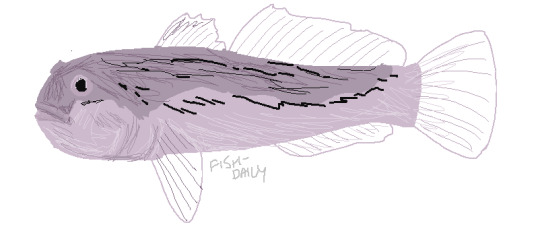
fish 124 - round gob-- oh fuc
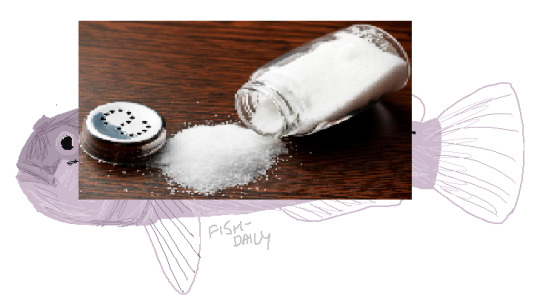
sorry :/
290 notes
·
View notes
Text



Some art from my wedding as little landscapes. The fish, the rocks and the landscape were cut from white paper and used to decorate a glass box.
81 notes
·
View notes
Text

Leopard-spotted goby
By: Douglas P. Wilson
From: The Fascinating Secrets of Oceans & Islands
1972
#goby#gobiiform#bony fish#fish#1972#1970s#Douglas P. Wilson#The Fascinating Secrets of Oceans & Islands
53 notes
·
View notes
Note
how is orbo and the others? (Most importantly orbo I am concerned for his healthy)

he good, he just round, what if he had ears what if they all had ears and stuffs and like whiskers
#gumball crew#orbo#original characters#ocs#art#artists on tumblr#digital art#ask#bopo#gumi#nene#mima#goby#suni
204 notes
·
View notes
Text



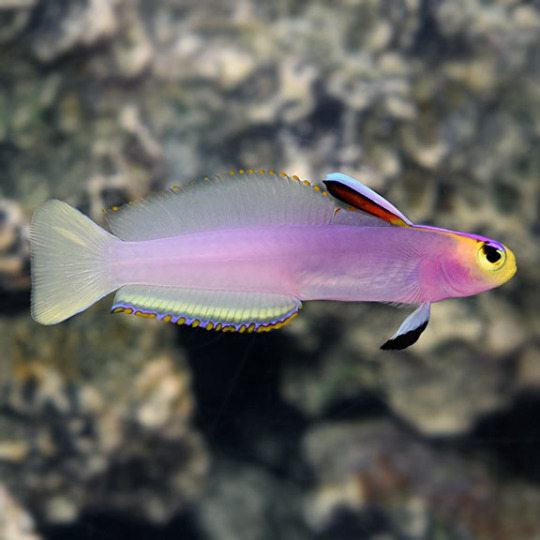

Firefish Goby Appreciation 🤍💛🧡❤️💜
#beauty under the waves#sea#ocean#underwater#marine wildlife#ocean life#saltwater#marine creatures#sea creatures#sealife#fish#firefish#goby#marine biology#animal#beautiful#small fish#stay salty#salt life
544 notes
·
View notes
Text
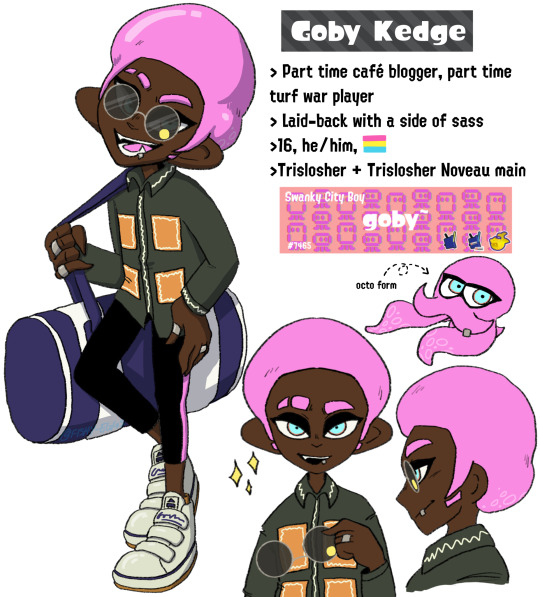
everyone say hello to my beautiful lil’ gumwad~ 💕
#splatoon#splatoon 3#octoling#octoling boy#splatoon oc#pink#goby#ooogh i love him sm…..#i cant wait to show you guys what i got planned for my ocs#evvy art
37 notes
·
View notes
Text
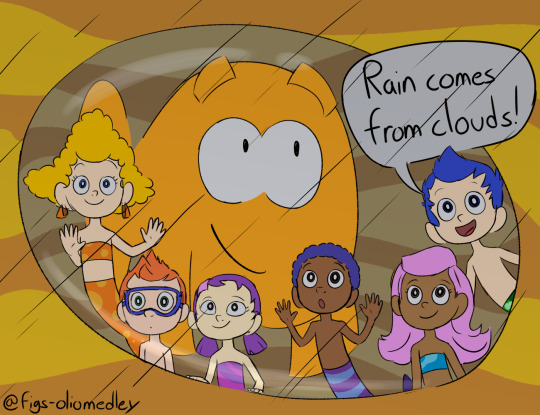
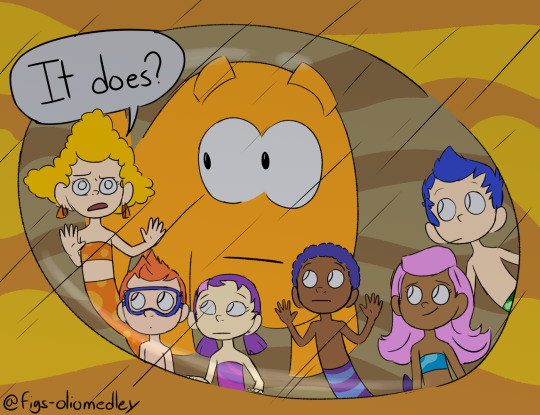
oh honey
turned on Bubble Guppies while I was making pancakes and remembered why I loved this show
god bless, Deema (also go listen to the songs they're genuine bangers)
#child me used to hate Mr Grouper but he's genuinely such a kind and sweet teacher#I think it's because he was one of two characters with those eyes#anyways#justicefornonny#his parents fucking hate him let him have a normal lunch#ffs#can't believe I drew Bubble Guppies (again technically) before Team Umizoomi#bubble guppies#molly#gil#goby#deema#oona#nonny#mr grouper#nick jr#digital art#really liked how this one turned out#real proud of the hands and proportions#only took me a day too >:3#my stuff
59 notes
·
View notes
Text
Daily fish fact #469
Spotted prawn goby!

They form symbiotic relationships with pistol shrimp! The shrimp lets the goby live in its burrow, and in exchange the goby acts as a kind of watchman for the nearly blind shrimp, alerting it of predators. This kind of bond will usually last for the entire life of both animals!
#fish#fishfact#fish facts#fishblr#marine biology#marine life#marine animals#sea creatures#sea animals#sea life#biology#zoology#spotted prawn goby#spotted shrimp goby#blackchest shrimp goby#goby#goby fish#mutualism#symbiosis
390 notes
·
View notes
Text

Boodart's Mudskipper aka Boddart's Goggle-eyed Goby (Boleophthalmus boddarti), family Oxudercidae, Laem Phak Bia, Phetchaburi, Thailand
photograph by JJ Harrison
235 notes
·
View notes
Text
Here are google picture examples:


113 notes
·
View notes
Text

@plasgeneration wrote the following:
#Goby The Fish is a #beach #sculpture that is being used to bring awareness about the damage done by plastic materials to marine life. The concept of Goby was created by #sculptor Janardhan Havanje and is structurally made of iron rods. Standing almost 10ft tall and 8ft wide Goby is filled with plastic waste that was collected from the beach itself. ture is also to bring awareness that #marine life in the #sea / #ocean is actually consuming the disposed #waste , and therefore we are losing many species of marine life due to #plastic waste, which is creating an imbalance in the #environment ”.
__
99 notes
·
View notes